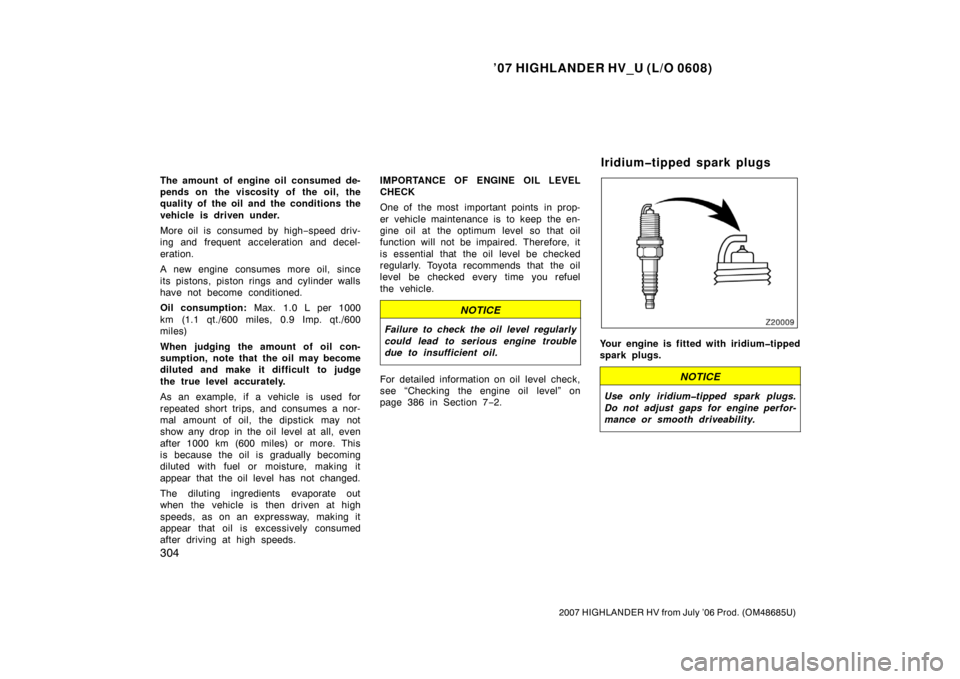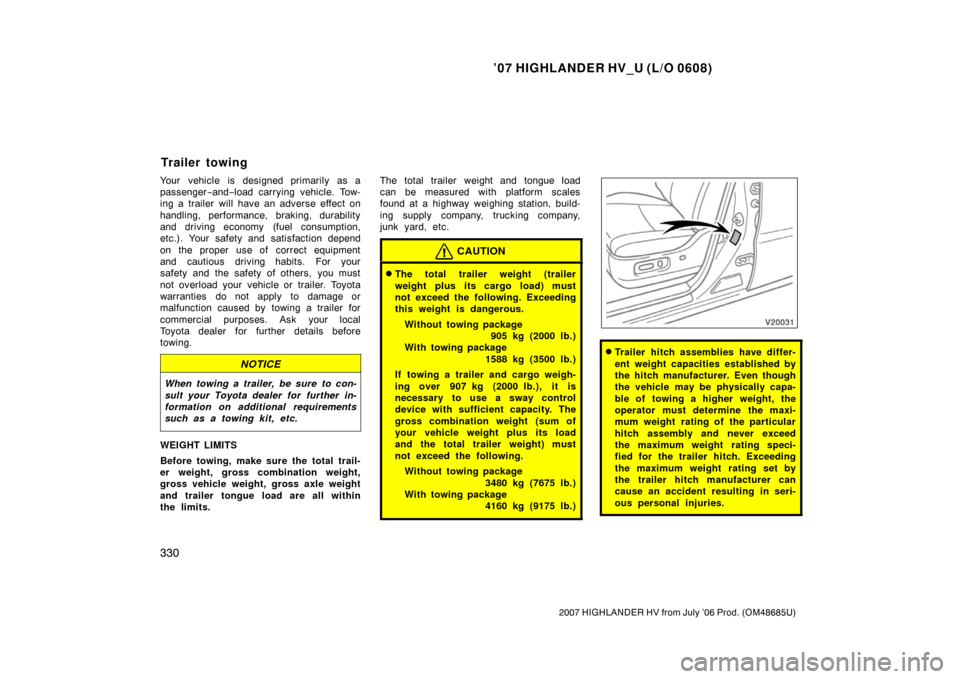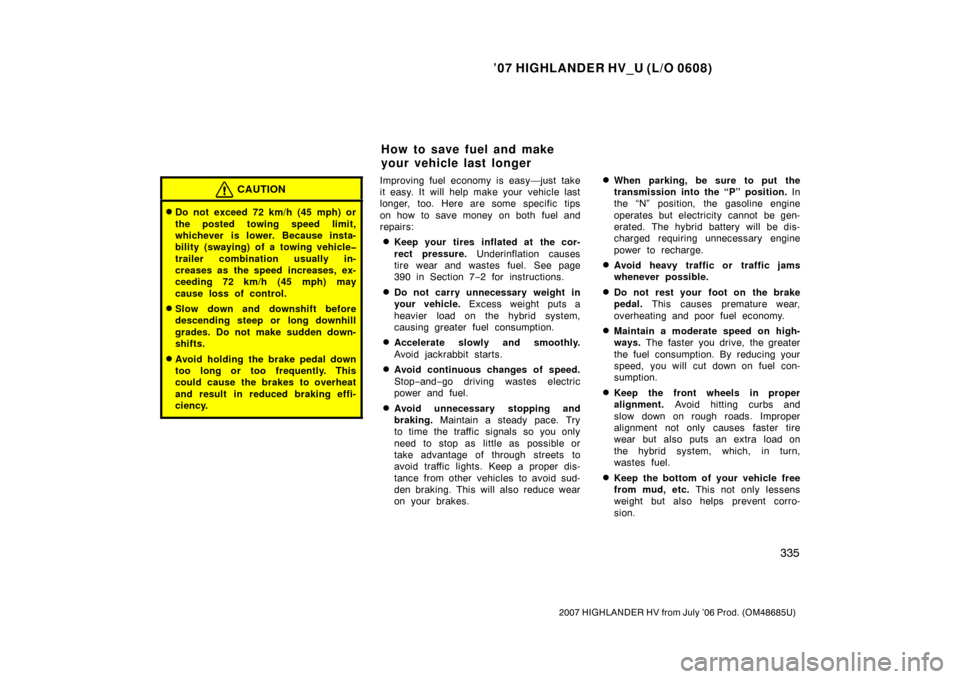Page 316 of 436

’07 HIGHLANDER HV_U (L/O 0608)
304
2007 HIGHLANDER HV from July ’06 Prod. (OM48685U)
The amount of engine oil consumed de-
pends on the viscosity of the oil, the
quality of the oil and the conditions the
vehicle is driven under.
More oil is consumed by high−speed driv-
ing and frequent acceleration and decel-
eration.
A new engine consumes more oil, since
its pistons, piston rings and cylinder walls
have not become conditioned.
Oil consumption: Max. 1.0 L per 1000
km (1.1 qt./600 miles, 0.9 Imp. qt./600
miles)
When judging the amount of oil con-
sumption, note that the oil may become
diluted and make it difficult to judge
the true level accurately.
As an example, if a vehicle is used for
repeated short trips, and consumes a nor-
mal amount of oil, the dipstick may not
show any drop in the oil level at all, even
after 1000 km (600 miles) or more. This
is because the oil is gradually becoming
diluted with fuel or moisture, making it
appear that the oil level has not changed.
The diluting ingredients evaporate out
when the vehicle is then driven at high
speeds, as on an expressway, making it
appear that oil is excessively consumed
after driving at high speeds. IMPORTANCE OF ENGINE OIL LEVEL
CHECK
One of the most important points in prop-
er vehicle maintenance is to keep the en-
gine oil at the optimum level so that oil
function will not be impaired. Therefore, it
is essential that the oil level be checked
regularly. Toyota recommends that the oil
level be checked every time you refuel
the vehicle.
NOTICE
Failure to check the oil level regularly
could lead to serious engine trouble
due to insufficient oil.
For detailed information on oil level check,
see “Checking the engine oil level” on
page 386 in Section 7
−2.
Your engine is fitted with iridium�tipped
spark plugs.
NOTICE
Use only iridium�tipped spark plugs.
Do not adjust gaps for engine perfor-
mance or smooth driveability.
Iridium�tipped spark plugs
Page 342 of 436

’07 HIGHLANDER HV_U (L/O 0608)
330
2007 HIGHLANDER HV from July ’06 Prod. (OM48685U)
Your vehicle is designed primarily as a
passenger−and− load carrying vehicle. Tow-
ing a trailer will have an adverse effect on
handling, performance, braking, durability
and driving economy (fuel consumption,
etc.). Your safety and satisfaction depend
on the proper use of correct equipment
and cautious driving habits. For your
safety and the safety of others, you must
not overload your vehicle or trailer. Toyota
warranties do not apply to damage or
malfunction caused by towing a trailer for
commercial purposes. Ask your local
Toyota dealer for further details before
towing.
NOTICE
When towing a trailer, be sure to con-
sult your Toyota dealer for further in-
formation on additional requirements
such as a towing kit, etc.
WEIGHT LIMITS
Before towing, make sure the total trail-
er weight, gross combination weight,
gross vehicle weight, gross axle weight
and trailer tongue load are all within
the limits. The total trailer weight and tongue load
can be measured with platform scales
found at a highway weighing station, build-
ing supply company, trucking company,
junk yard, etc.
CAUTION
�The total trailer weight (trailer
weight plus its cargo load) must
not exceed the following. Exceeding
this weight is dangerous.
Without towing package 905 kg (2000 lb.)
With towing package
1588 kg (3500 lb.)
If towing a trailer and cargo weigh-
ing over 907 kg (2000 lb.), it is
necessary to use a sway control
device with sufficient capacity. The
gross combination weight (sum of
your vehicle weight plus its load
and the total trailer weight) must
not exceed the following. Without towing package 3480 kg (7675 lb.)
With towing package 4160 kg (9175 lb.)
�Trailer hitch assemblies have differ-
ent weight capacities established by
the hitch manufacturer. Even though
the vehicle may be physically capa-
ble of towing a higher weight, the
operator must determine the maxi-
mum weight rating of the particular
hitch assembly and never exceed
the maximum weight rating speci-
fied for the trailer hitch. Exceeding
the maximum weight rating set by
the trailer hitch manufacturer can
cause an accident resulting in seri-
ous personal injuries.
Tr ailer to win g
Page 347 of 436

’07 HIGHLANDER HV_U (L/O 0608)
335
2007 HIGHLANDER HV from July ’06 Prod. (OM48685U)
CAUTION
�Do not exceed 72 km/h (45 mph) or
the posted towing speed limit,
whichever is lower. Because insta-
bility (swaying) of a towing vehicle�
trailer combination usually in-
creases as the speed increases, ex-
ceeding 72 km/h (45 mph) may
cause loss of control.
�Slow down and downshift before
descending steep or long downhill
grades. Do not make sudden down-
shifts.
�Avoid holding the brake pedal down
too long or too frequently. This
could cause the brakes to overheat
and result in reduced braking effi-
ciency.
Improving fuel economy is easy—just take
it easy. It will help make your vehicle last
longer, too. Here are some specific tips
on how to save money on both fuel and
repairs:
�Keep your tires inflated at the cor-
rect pressure. Underinflation causes
tire wear and wastes fuel. See page
390 in Section 7 −2 for instructions.
�Do not carry unnecessary weight in
your vehicle. Excess weight puts a
heavier load on the hybrid system,
causing greater fuel consumption.
�Accelerate slowly and smoothly.
Avoid jackrabbit starts.
�Avoid continuous changes of speed.
Stop −and− go driving wastes electric
power and fuel.
�Avoid unnecessary stopping and
braking. Maintain a steady pace. Try
to time the traffic signals so you only
need to stop as little as possible or
take advantage of through streets to
avoid traffic lights. Keep a proper dis-
tance from other vehicles to avoid sud-
den braking. This will also reduce wear
on your brakes.
�When parking, be sure to put the
transmission into the “P” position. In
the “N” position, the gasoline engine
operates but electricity cannot be gen-
erated. The hybrid battery will be dis-
charged requiring unnecessary engine
power to recharge.
�Avoid heavy traffic or traffic jams
whenever possible.
�Do not rest your foot on the brake
pedal. This causes premature wear,
overheating and poor fuel economy.
�Maintain a moderate speed on high-
ways. The faster you drive, the greater
the fuel consumption. By reducing your
speed, you will cut down on fuel con-
sumption.
�Keep the front wheels in proper
alignment. Avoid hitting curbs and
slow down on rough roads. Improper
alignment not only causes faster tire
wear but also puts an extra load on
the hybrid system, which, in turn,
wastes fuel.
�Keep the bottom of your vehicle free
from mud, etc. This not only lessens
weight but also helps prevent corro-
sion.
How to save fuel and make
your vehicle last longer